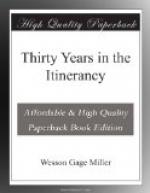The opening exercises of the service were not concluded before my course of action was decided upon. I read the note to the congregation, and stated that I had just found it on the desk. I further stated that I was at a loss to determine whether it was intended as a sneer at my old coat, or whether the writer really desired an exposition of the text named. But, believing that no one could so far forget a due sense of propriety as to deride honest poverty, or scoff at so faithful a servant as my old coat had been, even though it now began to show signs of age, I chose to take the latter view of the case. With this conviction, I should proceed to make the text the subject of the discourse. After giving the connection and context, I proceeded to define the subject of coats, arrange them into classes and set forth their uses. The spiritual application was not difficult, but it needed a little skill to cut the several styles so that each one could recognize his own pattern and appropriate the right garment. “Of course,” I remarked, “every one has heard of the garment of self-righteousness, though it may be that none in this congregation are aware of ever having seen it. Yet, should you chance to look upon it, with its straight seams and buckram collar, I am quite sure you would not prefer it to my old coat, unseemly as it may appear.” Thus the sermon went on, to “cut to order” and “fit to measure,” until all the most flagrant styles of coats had been disposed of, being careful, meantime, to institute the comparison in each case with the old coat before the audience. The discourse was perfectly ludicrous, but, like all of its kind, it took amazingly. Its financial success was, doubtless, all that the writer of the note had intended. On the next Sabbath morning the minister walked into church with a new outfit of wearing apparel, from the crown of the hat to the soles of the boots.
Watertown, from the first, was an unpromising field for ministerial labor. The leading influences at the beginning, if not directly opposed, were almost wholly indifferent to the claims of religion.
CHAPTER IX.
Waukesha—Old Prairieville Circuit—Changes—Rev.
L.F. Moulthrop—Rev.
Hooper Crews—Rev. J.M. Walker—Rev.
Washington Wilcox—Upper and Nether
Millstones—Our New Field—Revival—Four
Sermons—Platform Missionary
Meetings—The Orator—Donning
the Eldership—The Collection.
The General Conference of 1848 divided the Rock River Conference and formed the Wisconsin. The first session of the new Conference was held at Kenosha July 12th, and I was stationed at Waukesha.
It will be remembered that Prairieville was included in the Watertown charge in 1839, and formed one of the appointments established at that early day by Brother Frink. In the following year, when the Summit charge was formed, Prairieville fell into the new circuit. In 1841 Prairieville took the name of the charge, and henceforth became the mother of circuits in this portion of the Territory. Rev. John G. Whitcomb was appointed to the charge in 1842, and Rev. L.F. Moulthrop in 1843.




